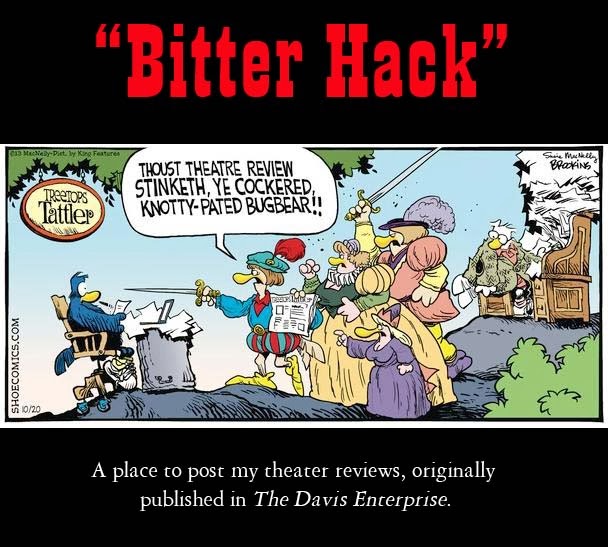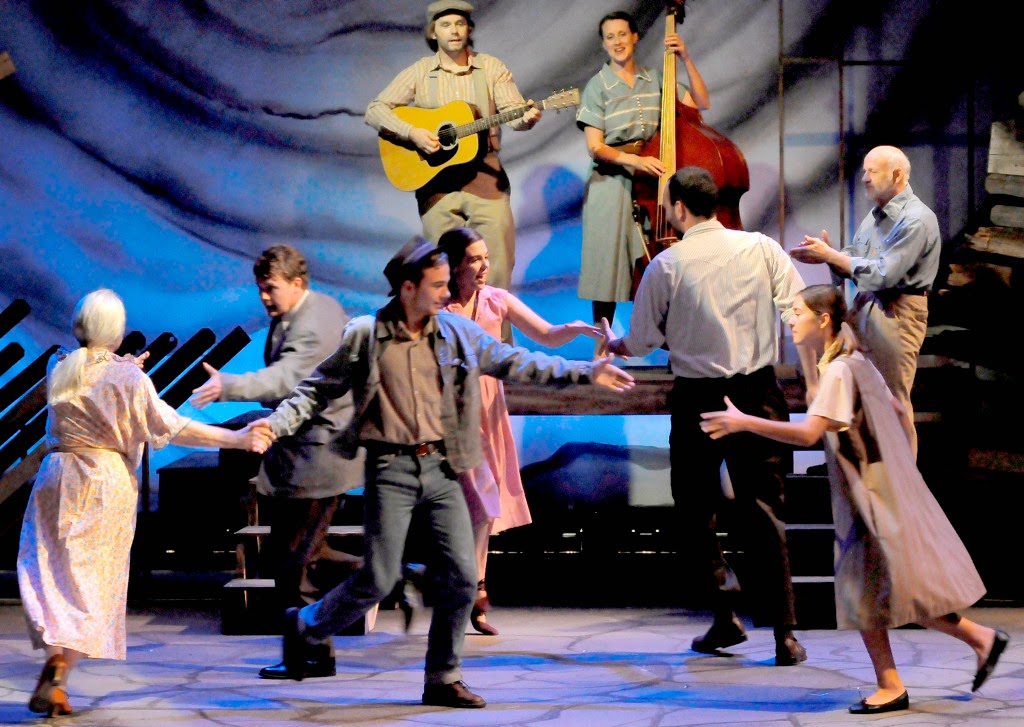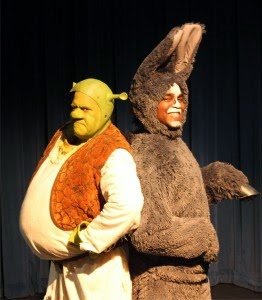A small number of lucky people had the good fortune to attend the opening of “The Fantasticks” at Wyatt Pavilion on Friday night.
This engaging production, with book and lyrics by Tom Jones and music by Harvey Schmidt is directed by Kathryn Morison and features Elio Gutierrez as El Gallo, Giana Gambardella as Luisa, Matt Skinner as Matt, Roberto Aguilar as Luisa’s father Bellomy, and Jason Moscato as Matt’s father Hucklebee. The traveling players are Matthew Benitez as Mortimer and David D’Olimpia as Henry. Edward Sukla is the Mute.
Music is listed as being provided by keyboardist Vuthithor “in” Chinthammit, who, not surprisingly, has no bio in the program.
“The Fantastics” is the world’s longest-running musical, having run an amazing 42 years, from 1960 to 2002 or 17,162 performances. It re-opened off Broadway in 2006 and continues to run today. It was awarded the Tony Honors for Excellence in Theater in 1991.
This is a popular show for high schools, and community theater since the set is minimal and the cast is small, but that should in no way minimize the impact of the simple story of a boy and a girl being tricked into falling love by their fathers, falling out of love, going out into the world and returning home again after negative experiences. They learn that if they want to find their hearts’ desire, they should look no further than their own back yard.
The small, intimate setting of the Wyatt Pavilion is perfect for this intimate show.
From the moment Elio Gutierrez makes his entrance as the narrator El Gallo (a role made famous by Jerry Orbach), singing the iconic “Try to Remember” and inviting the audience to use their imagination and follow him into a world of moonlight and magic. you know that you are in for something special. The charismatic Gutierrez is smooth and confident, with a sly hint of larceny about him from time to time. He dominates whenever he is on stage.
Gambardella is the innocent 16 year old Luisa, in her full-petticoated virginal dress designed by award winning Costume Designer Roxanne Femling. Gambardella’s voice is beautiful as she sings about her dreams (dance till 2 o’clock, wear her hair unfastened, and to be the kind of girl who is kissed on the eyes). She wants “Much More” out of life
Skinner’s Matt is a young man head over heels in love with the girl next door, whom he can only see over the unseen wall (mimed by Suela) the fathers built in a faux feud designed to make their children fall in love with each other, because the way to make children do what you want them to do is to tell them “no.”
Moscato and Aguilar give engaging performances as the two scheming fathers, eager for their children to be married to each other.
When the fathers decide it’s time for the young people to fall in love, Hucklebee tells Bellomy of his plan to end the feud by having Luisa "kidnapped" by a professional so that Matt can "rescue" her and appear heroic.
Things don’t quite go as planned, however. They meet with El Gallo, who is to arrange for an abduction. Discussion is made about what kind of abduction the fathers want. The fathers decide not to stint themselves, but do it well and settle on a “first class rape.”
D’Olimpia and Benitez as, respectively, ancient ham actor Henry and hangdog death-scene specialist Mortimer, hired as the would-be abductors, capture the audience with their antics.
Matt foils the abduction attempts, but exposure of the plot changes the relationship between Luisa and Matt and each decides to leave home and go out into the world, separately, to seek their heart’s desire. Returning later, dejected and emotionally injured, the children realize that everything they wanted was each other, only now they understand it more deeply.
This is a delightful production that deserves a wider audience than it got on opening night.
This engaging production, with book and lyrics by Tom Jones and music by Harvey Schmidt is directed by Kathryn Morison and features Elio Gutierrez as El Gallo, Giana Gambardella as Luisa, Matt Skinner as Matt, Roberto Aguilar as Luisa’s father Bellomy, and Jason Moscato as Matt’s father Hucklebee. The traveling players are Matthew Benitez as Mortimer and David D’Olimpia as Henry. Edward Sukla is the Mute.
Music is listed as being provided by keyboardist Vuthithor “in” Chinthammit, who, not surprisingly, has no bio in the program.
“The Fantastics” is the world’s longest-running musical, having run an amazing 42 years, from 1960 to 2002 or 17,162 performances. It re-opened off Broadway in 2006 and continues to run today. It was awarded the Tony Honors for Excellence in Theater in 1991.
This is a popular show for high schools, and community theater since the set is minimal and the cast is small, but that should in no way minimize the impact of the simple story of a boy and a girl being tricked into falling love by their fathers, falling out of love, going out into the world and returning home again after negative experiences. They learn that if they want to find their hearts’ desire, they should look no further than their own back yard.
The small, intimate setting of the Wyatt Pavilion is perfect for this intimate show.
From the moment Elio Gutierrez makes his entrance as the narrator El Gallo (a role made famous by Jerry Orbach), singing the iconic “Try to Remember” and inviting the audience to use their imagination and follow him into a world of moonlight and magic. you know that you are in for something special. The charismatic Gutierrez is smooth and confident, with a sly hint of larceny about him from time to time. He dominates whenever he is on stage.
Gambardella is the innocent 16 year old Luisa, in her full-petticoated virginal dress designed by award winning Costume Designer Roxanne Femling. Gambardella’s voice is beautiful as she sings about her dreams (dance till 2 o’clock, wear her hair unfastened, and to be the kind of girl who is kissed on the eyes). She wants “Much More” out of life
Skinner’s Matt is a young man head over heels in love with the girl next door, whom he can only see over the unseen wall (mimed by Suela) the fathers built in a faux feud designed to make their children fall in love with each other, because the way to make children do what you want them to do is to tell them “no.”
Moscato and Aguilar give engaging performances as the two scheming fathers, eager for their children to be married to each other.
When the fathers decide it’s time for the young people to fall in love, Hucklebee tells Bellomy of his plan to end the feud by having Luisa "kidnapped" by a professional so that Matt can "rescue" her and appear heroic.
Things don’t quite go as planned, however. They meet with El Gallo, who is to arrange for an abduction. Discussion is made about what kind of abduction the fathers want. The fathers decide not to stint themselves, but do it well and settle on a “first class rape.”
D’Olimpia and Benitez as, respectively, ancient ham actor Henry and hangdog death-scene specialist Mortimer, hired as the would-be abductors, capture the audience with their antics.
Matt foils the abduction attempts, but exposure of the plot changes the relationship between Luisa and Matt and each decides to leave home and go out into the world, separately, to seek their heart’s desire. Returning later, dejected and emotionally injured, the children realize that everything they wanted was each other, only now they understand it more deeply.
This is a delightful production that deserves a wider audience than it got on opening night.


















